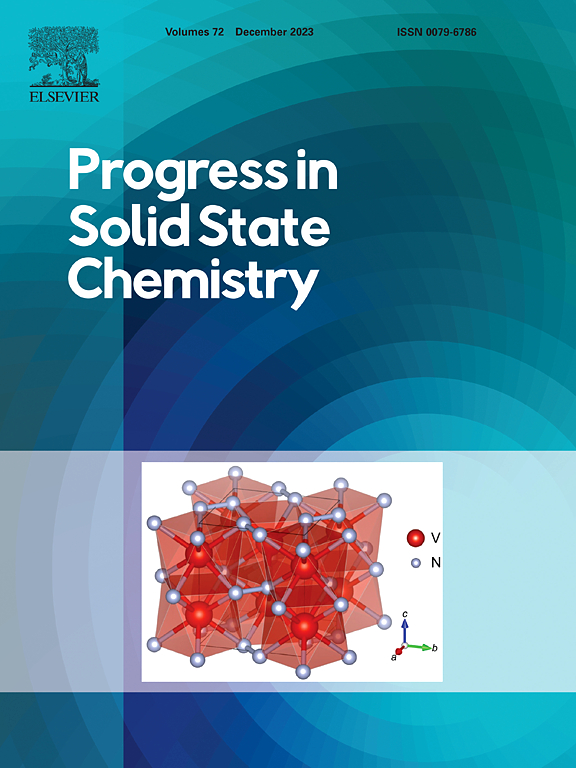Novel Mn5+-activated Ba2TiO4 phosphor emitting in the second near-infrared biological window
IF 10.5
2区 化学
Q1 CHEMISTRY, INORGANIC & NUCLEAR
引用次数: 0
Abstract
In recent years, second near-infrared window emitting phosphors have gained widespread research interest due to their excellent tissue penetration and high imaging accuracy. In this work, a new type of Ba2Ti1-xMnxO4+x/2 (0.02 ≤ x ≤ 0.10) phosphors were successfully prepared by high-temperature solid-phase method and their potential in luminescence thermometry is evaluated. PL and PLE spectral analysis prove that the optimal Mn doping concentration is x = 0.03. The as-synthesized phosphors exhibit a broad excitation band of 550–1000 nm and a narrow emission band of 1170–1220 nm. The electronic structures of the original Ba2TiO4 and Mn-doped Ba2TiO4 were calculated and analyzed using the DFT + U method, which facilitates a better understanding of the impact of Mn doping on the luminescent properties of Ba2TiO4. The luminescence decay lifetime is measured to be 101.44 μs at room temperature, which is a giant enhancement compared to conventional nanosecond lifetime phosphor, indicating a progress in imaging accuracy. In addition, the as-synthesized phosphors maintain over 75 % of the maximum luminescence intensity within the physiological temperature range. The potential applications in luminescence temperature measurement were also analyzed by the LIR ratio method, and the relative sensitivity could reach 2.31 %K−1 at 283 K, which is a relatively high value in the second near-infrared window. Therefore, the as-synthesized Ba2Ti1-xMnxO4+x/2 (0.02 ≤ x ≤ 0.10) phosphors demonstrate great potential in NIR applications such as biological imaging and luminescent thermometry.
新型 Mn5+ 激活的 Ba2TiO4 荧光粉在第二近红外生物窗口发光
近年来,第二种近红外窗口发射荧光粉因其出色的组织穿透性和高成像精度而获得了广泛的研究兴趣。本研究采用高温固相法成功制备了一种新型 Ba2Ti1-xMnxO4+x/2 (0.02 ≤ x ≤ 0.10)荧光粉,并评估了其在发光测温中的应用潜力。PL 和 PLE 光谱分析证明,最佳锰掺杂浓度为 x = 0.03。合成的荧光粉显示出 550-1000 纳米的宽激发带和 1170-1220 纳米的窄发射带。利用 DFT + U 方法计算并分析了原始 Ba2TiO4 和掺杂锰的 Ba2TiO4 的电子结构,从而更好地理解了掺杂锰对 Ba2TiO4 发光特性的影响。室温下测得的发光衰减寿命为 101.44 μs,与传统的纳秒寿命荧光粉相比有了大幅提高,这表明成像精度有了进步。此外,合成的荧光粉在生理温度范围内能保持 75% 以上的最大发光强度。我们还利用 LIR 比值法分析了发光温度测量的潜在应用,在 283 K 时,相对灵敏度可达 2.31 %K-1,这在第二近红外窗口中是一个相对较高的值。因此,合成的 Ba2Ti1-xMnxO4+x/2 (0.02 ≤ x ≤ 0.10)荧光粉在生物成像和发光测温等近红外应用领域具有很大的潜力。
本文章由计算机程序翻译,如有差异,请以英文原文为准。
求助全文
约1分钟内获得全文
求助全文
来源期刊

Progress in Solid State Chemistry
化学-无机化学与核化学
CiteScore
14.10
自引率
3.30%
发文量
12
期刊介绍:
Progress in Solid State Chemistry offers critical reviews and specialized articles written by leading experts in the field, providing a comprehensive view of solid-state chemistry. It addresses the challenge of dispersed literature by offering up-to-date assessments of research progress and recent developments. Emphasis is placed on the relationship between physical properties and structural chemistry, particularly imperfections like vacancies and dislocations. The reviews published in Progress in Solid State Chemistry emphasize critical evaluation of the field, along with indications of current problems and future directions. Papers are not intended to be bibliographic in nature but rather to inform a broad range of readers in an inherently multidisciplinary field by providing expert treatises oriented both towards specialists in different areas of the solid state and towards nonspecialists. The authorship is international, and the subject matter will be of interest to chemists, materials scientists, physicists, metallurgists, crystallographers, ceramists, and engineers interested in the solid state.
 求助内容:
求助内容: 应助结果提醒方式:
应助结果提醒方式:


